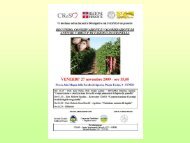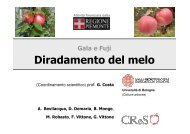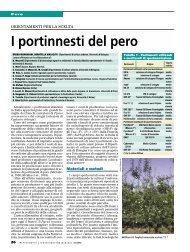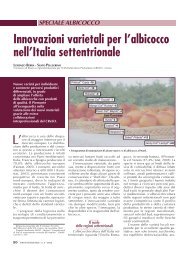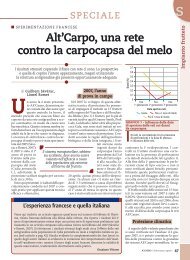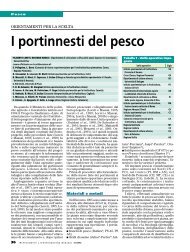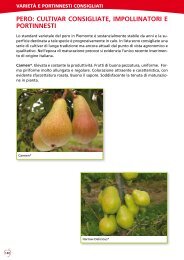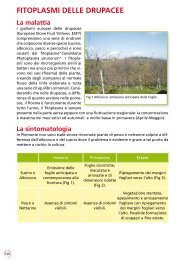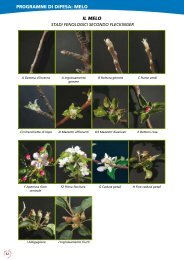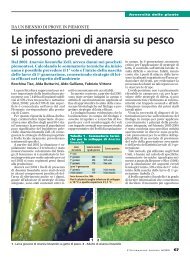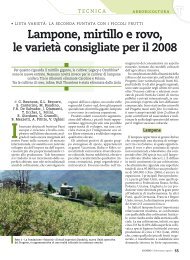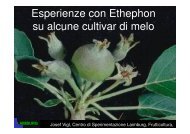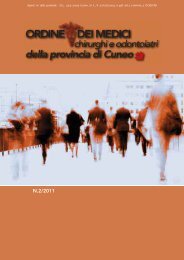la regolazione delle macchine irroratrici per i ... - InfoKeeper
la regolazione delle macchine irroratrici per i ... - InfoKeeper
la regolazione delle macchine irroratrici per i ... - InfoKeeper
You also want an ePaper? Increase the reach of your titles
YUMPU automatically turns print PDFs into web optimized ePapers that Google loves.
Progetto triennale di ricerca e s<strong>per</strong>imentazione a carattere<br />
applicativo finanziato dal<strong>la</strong> Regione Piemonte<br />
LA REGOLAZIONE DELLE MACCHINE<br />
IRRORATRICI PER I TRATTAMENTI ALLE<br />
COLTURE ARBOREE, CON PARTICOLARE<br />
RIFERIMENTO ALLA SCELTA DEI<br />
VOLUMI DI DISTRIBUZIONE E DELLA<br />
VELOCITÀ DELL’ARIA<br />
1° ANNO<br />
M. Tamagnone,<br />
G. Oggero,<br />
Balsari P.<br />
D. Demaria,<br />
G. Vittone
I PARTNER DEL PROGETTO<br />
COORDINATORE
OBIETTIVI DEL PROGETTO<br />
Fornire <strong>delle</strong> indicazioni<br />
pratiche agli agricoltori sulle<br />
modalità di rego<strong>la</strong>zione <strong>delle</strong><br />
<strong>macchine</strong> <strong>irroratrici</strong> utilizzate<br />
in frutteto con partico<strong>la</strong>re<br />
riferimento ai volumi di<br />
misce<strong>la</strong> e al<strong>la</strong> dose di<br />
fitofarmaco
RISULTATI ATTESI<br />
Migliorare <strong>la</strong> qualità del<strong>la</strong> distribuzione<br />
dei prodotti fitoiatrici in frutteto<br />
attraverso:<br />
1.riduzione dei volumi di misce<strong>la</strong><br />
impiegati<br />
2.incremento del deposito sul bersaglio<br />
3.riduzione dell’impiego di fitofarmaci<br />
4.riduzione <strong>delle</strong> <strong>per</strong>dite e dei prodotti<br />
reflui del trattamento<br />
5.incremento del<strong>la</strong> sicurezza ambientale
L’IRRORATRICE REALIZZATA<br />
SERBATOIO A<br />
(200+200+300 litri)<br />
MIXER<br />
SERBATOIO B<br />
(300+300 litri)<br />
Irroratrice multiserbatoio <strong>per</strong> prove parcel<strong>la</strong>ri con <strong>la</strong> quale<br />
è possibile variare i parametri o<strong>per</strong>ativi (portata ugelli,<br />
dose, velocità aria) senza scendere dal trattore
A<br />
B<br />
mixer<br />
Valvo<strong>la</strong> pressione el.<br />
Valvo<strong>la</strong> 2 vie motorizzata<br />
Valvo<strong>la</strong> 2 vie solenoide<br />
Valvo<strong>la</strong> 3 vie man.<br />
Valvo<strong>la</strong> 2 vie man.<br />
Valvo<strong>la</strong> di massima<br />
P<br />
Q<br />
R
Posizionamento e<br />
utilizzo del<br />
premisce<strong>la</strong>tore
2 serie di<br />
ugelli + 1<br />
<strong>per</strong><br />
antideriva<br />
Doppio manometro<br />
<strong>per</strong> verifica del<strong>la</strong><br />
pressione nei due<br />
circuiti
pressione (bar)<br />
16<br />
14<br />
12<br />
10<br />
8<br />
6<br />
4<br />
2<br />
0<br />
Range di volumi che è possibile distribuire con<br />
l’irroratrice realizzata<br />
1 serie di ugelli<br />
2 serie di ugelli<br />
400 600 800 1000 1200 1400 1600 1800 2000<br />
volume distribuito (l/ha)
marcia vento<strong>la</strong><br />
tesi<br />
frutteto<br />
sicurezza<br />
gruppo<br />
comando<br />
serbatoio<br />
interruttore<br />
generale<br />
<strong>la</strong>ti sx dx<br />
rego<strong>la</strong>zione<br />
pressione
1500 l/ha
400 l/ha
LA SPERIMENTAZIONE IN CAMPO<br />
Azienda Fruttico<strong>la</strong> GIRAUDO ORESTE e OSVALDO – Tarantasca (CN)<br />
VILLAFALLETTO<br />
TARANTASCA
LA SPERIMENTAZIONE IN CAMPO<br />
3 frutteti interessati<br />
• Mele Golden (grandi)<br />
• Mele Mariri Red (piccole)<br />
• Pesche Nectaros<br />
GOLDEN<br />
NECTAROS<br />
MARIRI RED
LA SPERIMENTAZIONE IN CAMPO<br />
Prove di efficacia biologica: 5 tesi <strong>per</strong> frutteto<br />
(campo s<strong>per</strong>imentale con parcelle a blocchi randomizzati)<br />
Mariri Red<br />
Golden<br />
Nectaros<br />
1 2 4<br />
5 3 4<br />
2 4 3<br />
4 3 5<br />
1 2 5<br />
1 5 2<br />
2 5 1<br />
4 1 1<br />
5 1 4<br />
3 4 2<br />
3 5 2<br />
4 3 5<br />
5 1 3<br />
2 4 3<br />
3 2 1<br />
1 blocco = 4 segmenti di fi<strong>la</strong>re<br />
lunghi 26 m
LA SPERIMENTAZIONE IN CAMPO<br />
Rilievo del<strong>la</strong> presenza dei principali patogeni e parassiti<br />
di melo e pesco prima e dopo i trattamenti fitoiatrici<br />
sul fi<strong>la</strong>re centrale del blocco
Cartelli <strong>per</strong> delimitazioni<br />
parcelle s<strong>per</strong>imentali<br />
visibili dal posto di guida
LA SPERIMENTAZIONE IN CAMPO<br />
Misurazione<br />
dimensioni <strong>delle</strong><br />
piante <strong>per</strong><br />
determinazione TRV<br />
(Tree Row Volume)
LA SPERIMENTAZIONE IN CAMPO<br />
piante piccole<br />
tesi 1 tesi 2 tesi 3 tesi 4 tesi 5<br />
volume l/ha 1500 1000 400 600 3 AI<br />
concentrazione g/hl 30 30 75 75 75<br />
dose g/ha 450 300 300 450 450 300<br />
piante grandi<br />
tesi 1 tesi 2 tesi 3 tesi 4 tesi 5<br />
volume l/ha 1500 1375 550 600 3 AI<br />
concentrazione g/hl 30 30 75 75 30<br />
dose g/ha 450 413 413 450 413<br />
tesi 1: volume tipico del<strong>la</strong> zona e dose piena<br />
tesi 2: volume e dose calco<strong>la</strong>te in base al TRV<br />
tesi 3: stessa dose di tesi 2 ma concentrata (volume ridotto)<br />
tesi 4: volume aziendale e dose piena<br />
tesi 5: come tesi 3 ma con ugelli antideriva
LA SPERIMENTAZIONE IN CAMPO<br />
Valutazione del<strong>la</strong> qualità del trattamento<br />
(con tracciante Giallo Tartrazina)<br />
•due epoche vegetative (vegetazione ridotta e<br />
completamente sviluppata sui tre frutteti)<br />
•due velocità dell’aria<br />
•5 tesi: 400 l/ha, 600 l/ha, 1000 l/ha, 1500 l/ha,<br />
400 l/ha con ugelli antideriva<br />
analisi<br />
spettrofotometrica<br />
dell’acqua di <strong>la</strong>vaggio<br />
dei campioni raccolti<br />
prodotto sulle foglie<br />
<strong>per</strong>dite a terra
LA SPERIMENTAZIONE IN CAMPO<br />
Posizionamento<br />
captatori (capsule Petri)<br />
<strong>per</strong> determinazione<br />
<strong>per</strong>dite a terra.
deposito di tracciante sulle foglie (µl/cm 2 )<br />
3.0<br />
2.5<br />
2.0<br />
1.5<br />
1.0<br />
0.5<br />
0.0<br />
aria bassa -<br />
normale<br />
I PRIMI RISULTATI<br />
Influenza del<strong>la</strong> velocità dell’aria e<br />
del tipo di ugello sul deposito<br />
fogliare (dati medi)<br />
aria alta - normale aria bassa -<br />
antideriva
I PRIMI RISULTATI<br />
deposito di tracciante sulle foglie (µl/cm 2 )<br />
3.0<br />
2.5<br />
2.0<br />
1.5<br />
1.0<br />
0.5<br />
0.0<br />
Depositi fogliari in funzione del<br />
volume distribuito<br />
mariri red<br />
golden<br />
nectaros<br />
400 600 800 1000 1200 1400 1600<br />
volume distribuito (l/ha)
I PRIMI RISULTATI<br />
deposito sulle foglie (µg/cm 2 )<br />
2.5<br />
2.0<br />
1.5<br />
1.0<br />
0.5<br />
0.0<br />
Deposito teorico di prodotto<br />
chimico sulle foglie<br />
0 500 1000 1500 2000<br />
volume distribuito (l/ha)
I PRIMI RISULTATI<br />
Afide grigio<br />
(% di germogli colpiti il 13 Maggio)<br />
10<br />
9<br />
8<br />
7<br />
6<br />
5<br />
4<br />
3.7<br />
% colonie morte<br />
% di 1-3 vive<br />
% di 3-10 vive<br />
% >10 vive<br />
3.7<br />
3<br />
2<br />
1<br />
0<br />
0.3<br />
0.2<br />
0<br />
0.7<br />
0.5<br />
0.8<br />
0<br />
0<br />
1.7<br />
1.7<br />
0.2<br />
0<br />
0.5<br />
0.2<br />
0.2<br />
1<br />
0.2<br />
0.3<br />
Tesi 1 Tesi 2 Tesi 3 Tesi 4 Tesi 5
I PRIMI RISULTATI<br />
Afide grigio (21 Maggio)<br />
(% di germogli colpiti il 13 Maggio)<br />
10<br />
9<br />
8<br />
7<br />
6<br />
5<br />
4<br />
% colonie morte<br />
% di 1-3 vive<br />
% di 3-10 vive<br />
% >10 vive<br />
3.7<br />
3.8<br />
3.8<br />
4.8<br />
3<br />
2.3<br />
2<br />
1<br />
0<br />
0.3<br />
0<br />
0<br />
0.2<br />
0<br />
0<br />
0<br />
0<br />
0<br />
0.2<br />
0<br />
0<br />
0.3<br />
0.3<br />
0<br />
Tesi 1 Tesi 2 Tesi 3 Tesi 4 Tesi 5
I PRIMI RISULTATI<br />
Ticchio<strong>la</strong>tura<br />
(foglie infette <strong>per</strong> ripetizione)<br />
5.0<br />
4.5<br />
4.0<br />
3.5<br />
3.0<br />
2.5<br />
2.0<br />
1.5<br />
1.65 1.55 1.45 1.55 1.45<br />
1.0<br />
0.5<br />
0.0<br />
Tesi 1 Tesi 2 Tesi 3 Tesi 4 Tesi 5
I PRIMI RISULTATI<br />
Afide verde<br />
(% di germogli colpiti il 27 agosto)<br />
10<br />
9<br />
8<br />
7<br />
7.0<br />
6<br />
5<br />
4<br />
4.8<br />
4.2<br />
3<br />
2<br />
1<br />
2.3<br />
2.5<br />
0<br />
Tesi 1 Tesi 2 Tesi 3 Tesi 4 Tesi 5
I PRIMI RISULTATI<br />
Bol<strong>la</strong> del pesco<br />
(% di germogli colpiti)<br />
20<br />
18<br />
16<br />
15.8<br />
12/05/2008<br />
16/06/2008<br />
14<br />
12.7<br />
12.5<br />
12<br />
11<br />
10<br />
8<br />
7.8<br />
6<br />
4<br />
5.5<br />
3.7<br />
3.0<br />
3.4<br />
4.8<br />
2<br />
0<br />
Tesi 1 Tesi 2 Tesi 3 Tesi 4 Tesi 5
I PRIMI RISULTATI<br />
Cydia molesta (% germogli colpiti)<br />
10<br />
9<br />
8<br />
7<br />
6<br />
5.8<br />
5<br />
4<br />
3<br />
2<br />
1<br />
2.0 2.1 2.1<br />
1.5<br />
1.2<br />
0<br />
Tesi 1<br />
Tesi 2<br />
Tesi 3<br />
Tesi 4<br />
Tesi 5<br />
Testimone
I PRIMI RISULTATI<br />
Cydia molesta (% frutti colpiti)<br />
10<br />
9<br />
8<br />
7<br />
6<br />
5<br />
4<br />
3<br />
2<br />
2.3<br />
2.0<br />
2.3<br />
1<br />
0<br />
0.3<br />
0.0<br />
Tesi 1 Tesi 2 Tesi 3 Tesi 4 Tesi 5
RINGRAZIAMENTI<br />
L’azienda GIRAUDO ORESTE e OSVALDO<br />
di Tarantasca<br />
Le ditte NOBILI SpA, PASCHETTA,<br />
BRAGLIA srl e ABBA’ snc



